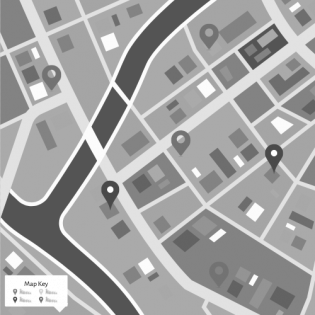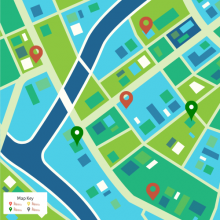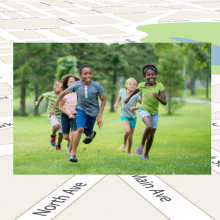Community Mapping Activity
Community Mapping Activity
This mapping activity gives a sense of what people and organizations are already doing related to an issue you care about. See the bottom of the page for a story of a youth using a map to guide his service project.
Definitions:
- community: people with common interests or who live in a common area
- community asset: a resource that has the potential to improve the quality of life within a community (e.g., a lake, a nonprofit, a farmer's market)
- association: a group of individuals united around a common goal that benefits the overall community
- institution: an established organization - such as a park, library, police station, or hospital - designed to benefit the overall community
- equitable representation: leadership and resources match the demographics of the community - For example, the percentage of women in leadership is the same as the population. This may be determined by gender, race, faith, LGBTQ+ orientation, or another characteristic.
Instructions
Determine Your Focus
With possibly hundreds of community organizations and assets in your area, it is important to focus on a single issue area to plot on the community map. Some youth have already observed a need and know what they care about. They can skip this first section.
Since the purpose of community mapping is to guide meaningful action, the focus should describe an identified need related to personal interests. Here are some service areas other youth have identified:- LGBTQ+ support resources
- sports training for low-income areas
- affordable art programs
- water quality resources
- mental health resources for young people
- safe places for teens
- intergenerational programs
- accessible recreation for people with disabilities
- environmental programs
- community support for refugee families
- food insecurity,
- social justice
- bullying
- equitable opportunities for youth
One of the following Learning to Give group activities can help identify the focus area for service action.
- Blue Sky Envisioning Activity - The participants envision their community or world in ten years and describe what it looks like. Then discuss first steps they can take toward their vision.
- Map Your Heartbreak - Change the World - When something moves your heart, you feel compelled to do something about it.
- Service Sparks: Spark a Giving Conversation - Conversations remind us we each have the power to make the world a better place through our voices, gifts, empathy, and action.
Write a Focus Question
Once you have completed one of the activities listed above, discuss the following questions.
- What needs have you observed in your community?
- What do you know or wonder about how this issue is addressed?
- What are some things your community is known for, or its assets?
- What would you most like to see changed in your community?
Work with a small group to write a focus question. A focus question has these qualities:
- A focus question guides the exploration and action. It asks where, how many, and for whom.
- The focus question is answerable by learning from nonprofits and people in your community.
- The question is open-ended, meaning it cannot be answered with yes or no.
- The question is driven by curiosity and a desire to explore how opportunities can be made better for all.
- When exploring and mapping, this question or statement drives the direction and scope.
Sample Focus Questions:
- What are the safe places in the community for young people to meet?
- What community resources address hunger and homelessness?
- How well do the community gardens match the diverse representation of the population?
- In what ways do museums, named buildings, benches, and art equitably represent the community's history and cultures?
- What affordable recreational (and health) opportunities are available to serve diverse people of all ages?
Collect Information and Plot on a Map
With the focus question as a guide, follow these steps to map the community assets and needs:
- Define the geographic area of the community to map. This may be as small as a neighborhood or as large as a county. A rural community likely merits a larger area. The focus of your survey may determine the region's size.
- Identify and research at least 5 - 7 organizations, people, or structures related to your focus in the defined geographic area. You can find this with an online search.
- Make a spreadsheet with categories related to your interest area. Make columns for the name and address. Other possible columns: purpose, identified need, who they serve, how they address the need, how to get involved, contact information, website.
- Contact individuals and nonprofits directly (or look them up online) to find out more about their work and how young people can get involved. Follow one of these guides to contacting organizations.
- Fill in details for each resource you contact on a Community Mapping Google Spreadsheet. Here is a sample spreadsheet you can adapt to fit. The information you collect on the spreadsheet should help you answer your focus question.
- Create a Google Map from the spreadsheet to highlight the organizations and information researched. This 5-minute video shows you how.
Analyze and Take Action
- Looking at your map, analyze how the identified resources fall in the region and why. How do the assets align with the needs, and where are the gaps?
- How well are the identified needs currently being addressed? According to the nonprofits interviewed, what are the needs they identified and how can young people help?
- Plan a service project that takes action toward addressing the identified need. For example, share the map and analysis with people who can support a project. Determine what you need to get started.
Story of a Map-Led Project
Ahmed already knew he wanted to take action to support refugee families in the community. Ahmed's mother was a child refugee whose family came to the U.S. and received help from nonprofits, faith-based groups, and individuals, so he wanted to help refugees feel included and supported. His focus question was "Where are the safe places for refugee children to play and meet others?"He looked up and filled in his spreadsheet information about the different nonprofits and faith-based organizations that help refugees. Then he interviewed a couple of organizations and learned that young children from refugee families enjoy meeting others and learning the language through games. He plotted on his map the organizations for refugees and where they had housing. On his map, he noticed a lot of families in a neighborhood with a park nearby. He worked with one of the nonprofits to organize a weekly activity night with games and crafts. With another nonprofit, they arranged to bring donated supplies and food.





